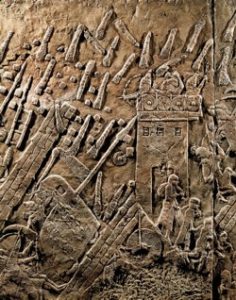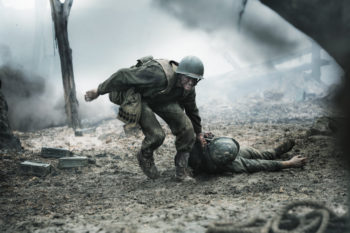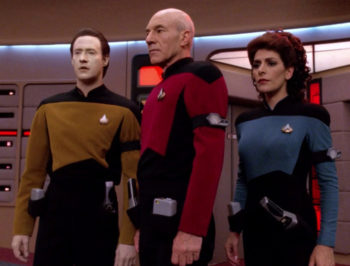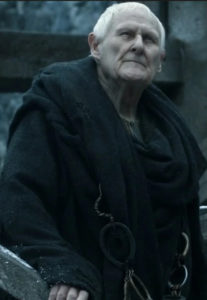Travis P here. Our last two posts have discussed training, the last one on the topic of combat arms training and the one before that on high-end capabilities, which are particular types of weapons that require a team (usually a large one) working together in a complex way to make an individual weapons system operate. This week we will discuss the training of combat support specialists, people who wear military uniforms and are trained in the basics of combat, but whose primary job is to support the war fighters rather than fight themselves. (Note that modern military studies distinguish between “combat support” and “combat service support”–I’m rolling both those terms together under the name of “combat support.”)
The earliest imaginable form of combat support would stem from ancient tribal warfare in which warriors (let’s be honest, they were almost always men) went out to battle and the wounded among those who survived to return home would be bandaged and given herbal remedies by village healers (who were, again, simply telling the truth, usually women). This generic type of scenario that played itself out throughout tribal societies across most of the globe is based on non-professional warriors, what I’ve previously called “barbarian” warriors (with no insult intended).
Early human literate civilization, the Mesopotamians, were the first to specifically train warriors to fight as a full-time profession. There’s no direct evidence I know of that they also incorporated combat support specialist into their military. Yes, by the time of the Neo-Assyrian Empire, a military we know a great deal about, it’s evident the Assyrian Army marched with various types of combat support personnel, to name only some of them: cooks, baggage handlers, chariot wheelwrights, healers, scribes who managed supplies and record keeping. But these activities were handled mainly by slaves or free non-military personnel. It wasn’t soldiers in combat armor, with combat training, performing these tasks, with one likely exception.

Assyrians attack the Judean fortified city of Lachish. Note the tower where Jewish bowmen are shooting down at the Assyrians, who are driving up a complex weapon with a long pole (a siege engine), which is itself riding on a ramp that was constructed by Assyrian engineers while defenders shot at them. (In this time-compressed image, Judean prisoners of war are shown impaled on stakes in the background, while women and children are shown peacefully leaving the tower to be exiled to Assyria, events that probably happened after the battle was over.) Part of a relief from the palace of Sennacherib at Nineveh. British Museum, London.
Military engineers, who were responsible for building ramps and bridges and various other instruments to breach enemy defenses may have been wearing armor and trained in combat. After all, their construction projects, such as the ramp leading to the wall of the Israelite city of Lachish, allowing access to siege engines that would destroy the wall (one of the high-end weapons systems of their day), was built under enemy arrow attack. It’s at least possible the engineers supervising the build represented a specific branch of the Assyrian military, military engineers. But not enough Assyrian history has been preserved to be certain of that.
By the time of the Roman Empire, there’s no longer any doubt. While the Roman army also employed non-military combat support personal (especially slaves/enemy POWs), Romans made use of military engineers, men in armor who were trained both in fighting and also what we can think of as the non-military profession of engineering, to support ongoing combat by building various kinds of structures. (Note that combat engineering, which is essentially blowing things up or otherwise destroying them, wasn’t its own specialty yet. Roman military engineers generally constructed devices rather than destroyed them–devices with war-related purposes, but still.)
The advantage of having your combat support personnel receive military training themselves is based on the fact it didn’t take ancient people long to figure out you can ruin an army by attacking its supplies, or baggage train, i.e. its combat support. The ancient solution to this problem was to divert combat troops to guard duty, protecting the supplies and support personnel.
Over a long period of time, militaries came to realize it’s actually more efficient to train the support personnel to defend themselves and to give them a common background with the combat arms personnel, allowing them to be integrated into combat units, where their early intervention is much more efficient than keeping military and civilian worlds entirely separate. The “early intervention” phrase especially applies to combat medics (a.k.a. corpsmen). A medical person in uniform in a combat formation can provide immediate life-saving help much more effectively than hoping a warrior survives wounds until the battle is over or he can be taken to the rear, when he can finally see a healer. But this also applies to a wide variety of other specialties–if it’s better to have your engineers or cooks or logistician or whomever nearby than far away in many situations. Which means it’s better to have them in uniform. (By the way, the person responsible for putting medics in combat units for the first time was Dominique Jean Larrey, a surgeon who served in Napoleon’s army.)
A military member with a non-combat job can be ordered into danger where civilians would be hesitant to go–and where they might have no idea what to do if they came under attack. In the Twentieth Century, the idea of training combat support troops really took off, modern militaries increasingly embracing the notion than they should be able to provide for themselves with support personnel in uniform. In World War I, roughly two-thirds of US troops were in combat specialties, only one-third support. By WWII, the support outnumbered the combat troops by 60% to 40%. In Korea and Vietnam, the WWI proportions flipped, so that only one third were combat forces and two thirds combat support. For the Cold War military in Germany, only 25% of the troops in uniform were combat arms specialists–75% were combat support.
The post-911 conflicts have hired more on-site civilian contractors to do jobs that belonged to combat personnel in the 20th Century militaries, so that in Iraq as of 2005, 40% of the US military forces in the country were in combat specialities, but if you take the civilian contractors into account, combat specialties accounted for only 28% of all United States military personnel in Iraq in 2005. (The source for the numbers quoted here are from a study for the US Army by John McGrath.)
It could be that the trend to reduce the number of combat support personnel increases over time. Though it could be that militaries of the future will turn both combat and non-combat roles over to robots and automated systems, in certain jobs, non-combat specialists are unlikely to ever be replaced (e.g. troop transport pilots), whereas in other jobs (e.g. cargo truck drivers), robots will likely take human jobs as soon as it’s feasible to do so. All things considered, he proportions of combat to combat support personnel should stay about the same for the foreseeable future.
Why do I bring all of this up?
First of all, I want the readers of this series to be aware of the existence of combat support military personnel. Many readers of this site are fantasy writers and fantasy worlds usually parallel medieval or ancient models of warfare. So your stories may not include non-combat specialists who are part of military organizations, i.e. personnel who receive military training. Yet the things the combat support specialists do need to be done by someone else. You need to keep that in mind.
Second, you should be aware of how already-existing speculative fiction has a times focused on combat support specialties. Star Trek has done so extensively, as Travis C will mention.
Third, this article intends to make you aware of the challenges of training someone to be fully proficient in a job that is essentially a non-combat profession, such as the military version of being a paramedic, but at the same time being proficient at warrior skills. It isn’t easy and for certain combat support specialties training can last much longer than combat arms training–usually, of course, the combat support troops are not as good at combat. But still, they can and do engage in combat as needed–and while they are in general in not as much danger as combat specialties, they can and do get wounded and killed in action. (Note Hollywood has produced at least one major movie that focused on the actions in combat and training of a combat support soldier–Hacksaw Ridge.)

Scene from Hacksaw Ridge, the graphic WW2 movie about a Christian pacifist who saved 75 lives during brutal combat. Image credit: The Catholic Sun
Fourth, I want story makers to be aware that stories can be told from the point of view of combat support troops–and such stories are not necessarily less interesting than hearing about the most elite troops fighting as consummate professionals. This especially relates to the fact many groups in the history of Christianity have been pacifists–but as combat support soldiers, they could be thrust into a combat situation nonetheless (as per Hacksaw Ridge and my own science fiction short novella on Amazon, Unknown Biologic).
Travis C here with some helpful illustrations of our combat support topic. To highlight Travis P’s last point, my favorite series in recent years is Glen Cook’s The Black Company, which is told through via point of view of the mercenary company’s doctor, who happens to function as the Annalist or historian. In this role, Croaker has first-hand knowledge and a legitimate reason to describe the deeds of the Company, and I feel the series is better because of that unique viewpoint.
If you’re in the world-building phase, it’s worth spending a little bit of time thinking through what combat support functions need to be identified and further worked out before the story progresses. Readers will tell if you’ve created a military juggernaut of combat capability that has little support structure and would never actually last a day in the field. That said, you also don’t need to develop detailed doctrine about supply depot procedures for turnips (unless that supports the story, of course!) A few things to consider:
- What functions need to get accomplished? Travis P mentioned several: medical, logistics of moving troops and supplies, the supplies themselves, quarters for troops, repair and maintenance of equipment, other engineering needs, etc.
- Who is going to accomplish those functions? Regular troopers, trained but non-fighting personnel, volunteers, families, slaves?
- Does the success of, or lack/failure of, one of those functions become a necessary plot element in the story?
- If so, what additional detail should be developed to add color to the picture?
If you answered “Yes” to question 3, then there’s lots of great examples in literature and media demonstrating unique ways to include this information, weave it into the story world, and really impact the audience. Here are 3 that come to mind:
Make It Easy To Identify Combat Support

The three colors of Starfleet uniforms, marking specialties. Image Credit: memory-alph.wikia.com
In particular during The Next Generation, Star Trek used color to train its viewers to identify the various roles found across the Federation’s Starfleet. Three primary colors: red, blue, and gold, were an easy way to distinguish between Command, Sciences (including medical), and Operations. Red and Gold uniforms kept the ships running and may and may not have been directly related to combat, but blue uniforms were a clear sign of a combat support specialist.
As an audience, we had expectations for any character depending on the color of their uniform. Red represented leadership and tactical training, blue an intellectual mind and appreciation for research and exploration, and gold the detail-oriented mind of an planner and engineering expertise to run a warp core. As expected, the writers of successive iterations of the Star Trek universe then flipped those expectations on their heads. The interplay between divisions yields great plot lines to explore ethics and relationships among characters.
Every George R.R. Martin reader knows the Night’s Watch has its own maester to perform record keeping and healing. The clink of their maester’s chain identifies those trained by the Citadel.

A maester and his chain. Image credit: gameofthronesfandom. fandom.com/wiki
There’s probably a unique way you can easily help readers identify with the combat support functions, understand how they are different from the combat arms characters, and help build structure in your world.
Understand the Tension Between Combat Arms and Combat Support
That’s probably not a surprise, but I think it’s safe to say even the “barbarian” form of combat support garnered no small amount of tension. One party is doing the fighting, right in harm’s way, and subjecting themselves to imminent danger. The other side is waiting in the wings, perceived as being away from danger, but likely at more risk since the enemy knows how critical these roles are. Grunts are just dumb killers. Support are just scared weaklings incapable of doing more. You likely know these tropes already.
We’ve used Brandon Sanderson’s Stormlight Archives several times already, but here’s an example of the use of bridge crews (manned by slaves, unprotected from enemy fire, yet vital to movement of the armies across the Shattered Plains) to meet a critical support function with significant contrast to the armies and Brightlords conducting combat. Sanderson not only uses Kaladin as one of his main characters, but also uses the tension between organizations to drive the plot forward.
David Farland’s second book of the Runelords series, Brotherhood of the Wolf (not to be confused with a film with the same name), does an excellent job of using the connection between Runelords who take endowments of power to those who give up those powers ( called Dedicates) to drive the story forward. The military cannot function without the enhanced abilities of strength, metabolism, wit, and senses that the Dedicates give up. At the same time, these Dedicates are ideal targets for military action since killing a Dedicate will immediately remove that attribute from the bearer. The Dedicates require significant protection, at the cost of military flexibility. Farland excellently uses this interplay to develop characters and add tension to the plot.
Change Your Point of View
Lastly, and in line with my shared favorite, consider if you should add a different point of view to your story. We’ve all heard stories told from the perspective of the knight, the lord, the king, the starship captain, the great-grand-poobah. We’ve also watched the unlikely hero become a military mastermind (and as we’ve discussed earlier in the series, just how unlikely that is). What about the war told through the eyes of the frontline surgeon? The sapper digging under the castle walls? The cook hearing everyone’s stories at the end of the fight? The engineer keeping the hypercore going on that rust-bucket starfrigate? It may not be the primary point of view or main character you develop a story around, but these secondary characters can add a lot of detail in interesting ways as interludes, prologues and epilogues, or even just scenes spread through the story.
Just like the combat arms functions, combat support has its own training needs that can add even more detail to your worlds. Maybe as backstory, maybe as a source of tension between combat functions, maybe just for fun. Being honest about how the military works in the context of your world is vital to building meaningful engagement with a reader. Plus, it’ll help you when you’ve got a few more chapters to fill and want a way to show, not tell, what’s happening in your military stories.
Comments
Post a Comment